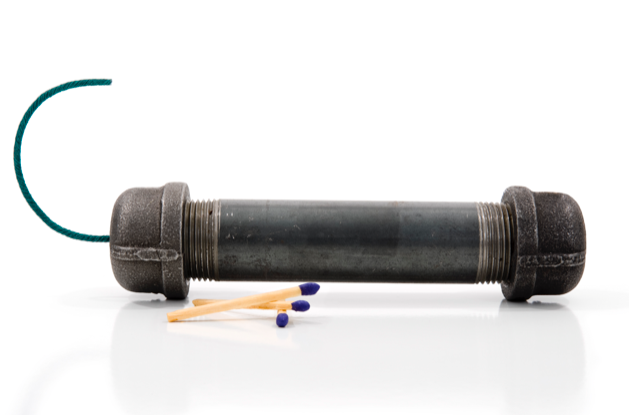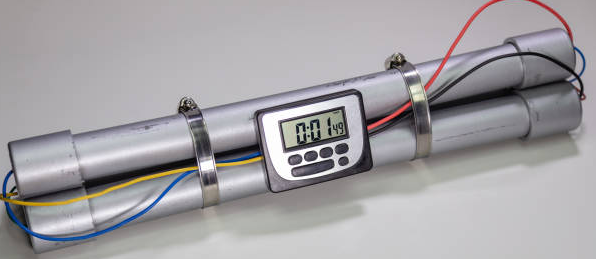SWAT: EVALUATING THE IED THREAT
- paladintacticalus
- Dec 20, 2021
- 5 min read
Updated: Mar 28, 2023
I had the opportunity to serve as an evaluator for a large-scale SWAT exercise where numerous teams rotated through scenarios throughout the day. In our particular scenario, the team responded to an active shooter in a commercial building. As they entered, they came across several dead, dying, or injured victims. Shortly thereafter, gunshots prompted them to move toward a threat located deeper in the structure. Once the teams found and neutralized the shooters, they discovered a fused pipe bomb near one of the suspect’s bodies.
By observing how several teams approached this problem, it was evident where improvements can be made in training and SOP development. The good news is that these issues can be easily resolved with 1) basic training regarding hazardous devices and 2) adding a new team SOP for handling devices which are dangerous, but inherently stable.
GET-OUT-NOW!
Most SWAT teams have a code word which directs operators to stop the mission and evacuate to a safe rally point. This call is made by a team member who observes an imminent threat to the team. This threat usually manifests itself as an Improvised Explosive Device (IED) or a chemical/biological/radiological agent. Many teams use the same code word which I will not reveal on an open forum. For the purposes of this article, we will use GET-OUT-NOW as a substitute for the code word.
During this SWAT exercise, most teams made a GET-OUT-NOW call after observing the IED. Upon evacuating the building, they met up with a bomb technician and reported what they found. The team re-entered the building accompanied by the bomb tech who visually evaluated the bomb. He immediately recognized that the pipe bomb could only be detonated by lighting its fuse. He advised that the device was stable and it was safe to continue their operation if the bomb remained undisturbed.

So, that sounds like it went well, right? Unfortunately, upon making the GET-OUT-NOW call, a few teams evacuated the building while leaving behind ALL of the injured victims. Based on the subsequent assessment by the bomb technician that the device was stable, it was then evident to the teams that they overreacted to the situation with their hasty evacuation (and abandonment of the injured). For teams that left the victims inside, valuable time was lost to provide for their medical care. In this case, the bomb technician was staged just outside of the door and it took approximately 5 minutes before the team could re-start the evacuation process. In a real-world situation, a bomb technician may not be on-scene and the time to assess the device may be much longer. Every minute counts when dealing with traumatic injuries.
TAKE 'EM OR LEAVE 'EM
One of the guiding principles in law enforcement is the Priority of Life. In most cases, we prioritize in the following order: 1) hostage/victims, 2) officers, and 3) suspects. In the case of an GET-OUT-NOW call where officers left behind injured victims in order to escape, we must acknowledge that officers prioritized themselves over the victims. That said, this isn't always the wrong decision because in some cases, switching the order may be justified. For example, if an an officer has a reasonable belief that a victim is already dead or about to die, then it would be prudent to prioritize his life over the victim. We should not trade healthy operators for dead/dying victims. This is simply “triaging” those at the scene.
As an example of an GET-OUT-NOW triage, the female in the top image should be evacuated with the team. She is conscious, unable to move, and bleeding from the abdomen and leg. She will likely survive her wounds if she receives timely medical care. However, if she is left behind during an GET-OUT-NOW call, she could perish from loss of blood. In contrast, the two victims in the bottom image appear deceased; law enforcement must decide whether they have the time to evaluate/extract them during an immediate threat to their lives by an IED.


With regard to the training exercise, approximately half the victims fell into each category. Therefore, there were several victims who could have survived if they had been removed during the GET-OUT-NOW evacuation.
WHAT'S THE FIX?
First, operators must acquire the basic knowledge to differentiate between a device which is an immediate threat to life versus a stable one. A fused pipe bomb, a jar of botulinum toxin, or a sealed tank of chlorine gas are dangerous; however, they are not an immediate threat if they are not lit, broken, or opened, respectively. On the other hand, imminent threats would include an IED with an active timer or a remote control mechanism (cell phone, wires leading to a separate location, etc) or the presence of noxious fumes. In these cases, immediate evacuation is necessary while removing as many victims as reasonable under these circumstances.

SWAT teams should seek basic training from their agency’s bomb technicians and local hazardous materials teams. The emphasis should be on how to evaluate whether a device/item is stable or an imminent threat. With this knowledge, teams will properly classify the threat and take appropriate actions when confronted with these types of situations.
Second, in addition to the GET-OUT-NOW procedure, teams should incorporate a new SOP which communicates that a potential threat is present, but it is NOT an imminent danger to life. My former team used another code word for this condition. We'll call it GET-OUT-SOON for the purposes of this article. Upon the GET-OUT-SOON call, the team would move quickly, but still accomplish the mission before leaving the area.
With regard to above scenario, the best course of action would've been a GET-OUT-SOON call, followed with a description of the device and its location. Two operators would guard the device (incorporating distance and shielding) while the rest of the team would continue clearing the building and quickly evacuate the injured to the CCP. Once operators and the injured were in a safe location, the team leader would advise the bomb technician of the device and escort him into the building with a small security element for his initial evaluation.
BOTTOM LINE
1) Know how to differentiate between a GET-OUT-NOW and a GET-OUT-SOON situation. If it's a GET-OUT-SOON, accomplish the mission while reducing your time inside the structure. Extract all injured parties to the CCP before the team leaves the building.
2) If it is truly an GET-OUT-NOW situation, then quickly triage the victims as you evacuate. Take as many viable victims with you as possible. Those who appear dead/dying should be left behind if you believe the risk to operators is too high.
It's always easy to Monday-morning quarterback those who are "in the arena." My intent is to not come across as a critic. I hope that my observations and experience may help our law enforcement teams improve their capabilities when dealing with these chaotic situations.

Comments